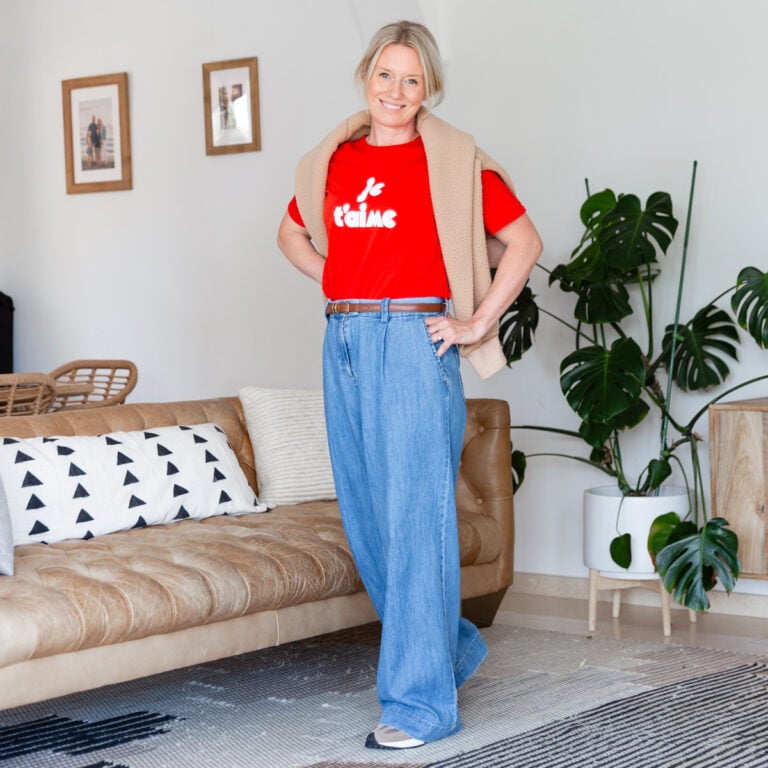How to Declutter Sentimental Items
Surrounded by boxes of sentimental items? We’ve all been there! This guide offers a gentle approach to letting go, helping you create a space that reflects your present self while honoring those cherished memories.

When it comes to stuff, I can confidently say I’m fairly minimalist these days. I’ve decluttered much of our home and am constantly evaluating what sparks joy and what doesn’t.
But a few things still hold me back.
Like the stack of graduate school notes and textbooks that have moved across the world with me, from North Carolina to San Francisco, Oregon, and most recently, to Spain, I tell myself I’m holding onto them “just in case” I need them someday—but the truth is those notebooks contain memories I don’t want to forget and represent one of my greatest accomplishments in life.
Alongside those textbooks sits a brand-new Burberry wallet, a near-decade-old gift from my loving husband. It’s beautiful; it’s just not me. Logically, selling it makes sense. It’s never been used, and the money could be put towards something we’d both enjoy (hello romantic overnight!). I know this, yet the idea of parting with it feels like I’m rejecting my husband’s thoughtful gesture.
Whether it’s things from our childhood, items we inherited from a beloved family member, or unwanted gifts we’ve received over the years, we all have things we hang on to because, well, letting go feels harder.
Over time, though, too many special things can become sentimental clutter that prevents us from fully appreciating the memories. Too much stuff also increases stress and makes our homes more difficult to manage.
That’s where decluttering comes in.
I haven’t quite conquered everything yet (looking at you, Burberry!), but this decluttering journey has taught me why we feel an emotional attachment to our stuff and helpful strategies for finding a balance. It’s allowed our family of four to move to a new country with minimal belongings—the most important ones.
By approaching it thoughtfully, you can create a home that reflects the memories you cherish most while also freeing up mental space and making room for new memories and experiences to come. I hope this guide will equip you with the tools to start tackling your sentimental things with confidence.
What are sentimental items?
The struggle to let go of certain possessions (like my unused Burberry wallet) highlights a surprising truth…
Sentimental items aren’t just “things” taking up space; they’re powerful reminders of important memories, loved ones, and experiences that have shaped who we are. They hold emotions and stories and are a powerful connection to our past. They can make us feel and remember people, places, and experiences we don’t want to forget.
Sentimental items examples
Anything can have sentimental value, but here are some of the common sentimental items you might come across:
- Family heirlooms, including jewelry, furniture, silverware, quilts, artwork, family documents and letters
- Personal keepsakes and momentos like childhood toys, baby clothes, awards, trophies, ticket stubs, old love letters, a favorite old t-shirt, or a wedding dress
- Crafts and artwork made by you or someone you love
- Old photos, high school yearbooks, letters, cards, emails, journals, souvenirs, or other tangible reminders of life’s journeys
- Meaningful gifts given to you by loved ones
- Collectibles like baseball cards, stamp collections, vintage dolls, vintage dishware, etc.
Preparing to declutter sentimental items
We can all agree that letting go of sentimental stuff requires a different approach than decluttering a sock drawer.
Diving in headfirst can be a recipe for overwhelm and regret. Unlike that overflowing sock drawer, these cherished possessions hold precious memories, powerful emotions, and meaningful stories. They deserve a more thoughtful approach, one that takes time and energy to process. Here are some tips to prepare yourself to tackle the tough stuff.
Identify your sentimental items
Old notebooks or a designer wallet from a loved one might hold little emotional weight for some. (For the record, I never expected those items to linger in my possession for so long!) But the truth is, we all have those things that tug at the heartstrings, even if we’re not fully aware of what they are.
The first step of letting go is understanding why we hold onto certain items. Look around at the things you’ve been putting off going through. Chances are many of them have special meanings, memories, or emotions attached.
Once you know what holds sentimental value, you can sort through these items more practically, while still honoring the emotional connection.
Acknowledge the uncomfortable feelings
When you declutter sentimental items, you may encounter feelings, emotions, or thoughts that might make it difficult to decide whether or not to let something go. Some of these may include:
- Fear of forgetting memories
- Guilt or obligation to hold onto something
- Worry over “What if” scenarios
- Emotional overwhelm and decision fatigue
Feelings of fear, guilt, worry, or overwhelm are often part of the process of decluttering sentimental objects, but understanding them empowers you to make more rational decisions about whether something is truly worth keeping.
Define what “enough” means to you
“Enough is a decision, not a certain amount.” This simple quote is a great reminder that you don’t need to hold onto everything to hold onto your memories. Defining what “enough” means for you allows you to identify the items that hold the most significance and let go of everything else.
Give yourself space and time
Decluttering sentimental items can be an emotional journey. After all, accumulating so many personal belongings can take years, even decades. Give yourself space and acknowledge that sorting through these cherished objects will require time and persistence.
Find a friend, family member, or professional organizer to help
Tackling sentimental items alone can feel overwhelming, even a bit lonely. But you don’t have to go it alone. Recruiting a decluttering buddy—a trusted friend, family member, or even a professional organizer—can lighten the mental and physical load and help you through making those tough decisions.
How to declutter sentimental items (Step-by-step process)
In my experiences decluttering our family’s most special items, I’ve found a step-by-step decluttering process that works. This approach will allow you to make progress without feeling overwhelmed and let you tackle those cherished belongings with confidence.
Step 1: Choose a manageable project
Rather than tackling the boxes of sentimental items in “the basement” or “the attic,” choose something specific to work on for 20-30 minutes. For example, a box of family photos, a collection of kids’ artwork, or a childhood toybox. Keeping the project focused allows you to see progress quickly and keeps the project from feeling overwhelming.
Step 2: Gather everything in one spot
Once you’ve chosen a category, hunt down all of those items in your house and bring them together in a central location, like a dining room table or on the floor—wherever you have space.
I picked this tip up from Marie Kondo’s Netflix series a few years back. I rolled my eyes at first—but it works! Here’s why:
Seeing everything together gives you perspective on how much you have (which is usually much more than you think when items are spread throughout the house.)
Seeing everything in one place also puts things in context. It is easier to categorize, compare, and decide about individual items when you can see the whole collection together.
Sorting through everything and creating separate piles can also be a powerful visual reminder of how much you’re keeping, not just discarding.
Step 3: Set boundaries around what you will keep
When decluttering, I always find it helpful to set boundaries around what I will keep. This might be a certain number of things (like 3 favorite toys from when you were a kid), or a defined amount of space that something can take up (for example, one shoebox for old family photos). Setting some boundaries up front will help you hone in on your favorites as you go.
Step 4: Grab your supplies and set a timer
With everything now in front of you and your boundaries in mind, it’s time to turn off the TV, silence your cell phone, and gather your supplies.
Here’s what I like to have on hand:
- 3-4 boxes, trash bags, or pieces of paper labeled“Keep,” “Donate,” “Sell,” and “Trash/Recycle” to keep your piles organized
- A hand vacuum and a couple of microfiber cloths (one damp, one dry) to keep dust bunnies at bay
- My phone to take pictures of items I’m letting go of (wonderful for preserving memories!)
Once your supplies are ready, set a timer for 20-30 minutes, max. Working against the clock will nudge you to make decisions more quickly and give you an endpoint so you don’t wind up exhausted and completely overwhelmed. You’ll be surprised by how much you can accomplish in a short burst of distraction-free decluttering!
Step 5: Sort with purpose (use the question guide below)
Now that you’re focused and have a plan, it’s decision time! If you’re having a hard time with something, use the following questions as a guide to help you make a decision.
How does this item make me feel? Does it evoke a special memory or give you a warm and fuzzy feeling? If so, it might be worth keeping. If the memory is vague or negative, consider letting it go.
Why am I keeping this? Is it a fear of forgetting, worry over needing it in the future, or because you love and use it? We hold onto things for all sorts of reasons—some logical, some not
Does this item bring me joy? It might be time to let it go if it doesn’t bring back a happy memory or make you smile.
Does it take up valuable space? Consider if the space this item occupies could be used for something more important to you right now.
When was the last time I used it? If it’s been years since you’ve interacted with it, it’s probably not serving you now.
Do I already have something similar? If yes, which one do you prefer?
Does this fit within what I’ve said I would keep? If not, re-evaluate what you’ve decided to keep.
Could a photo capture the memory? Oftentimes, a simple photo can free you from keeping the physical object.
What would I keep if I couldn’t keep it all? If you had to choose just a few sentimental items from a loved one or chapter in your life, which would they be?
What if I lost this in a fire? Would you feel a deep sense of loss? If yes, it likely holds significant sentimental value. If not, consider letting it go.
Can I keep a small part rather than the whole thing? For collections, consider selecting a few key pieces. For example, with my children’s schoolwork, instead of keeping every semester’s pile, I save one or two pages from each subject along with a writing sample. This allows me to capture the memory without holding onto everything.
Could someone else enjoy this item? Consider selling, gifting, or donating loved items to give them a new life. More on that below!
How will I use or display this item? Carefully consider things that will likely end back up in a box.
Do I want this to become someone else’s responsibility? Consider if holding onto these things will burden loved ones in the future.
Does this sentimental object match your life? Does it fit your current style and needs, and support the life you want to create?
By asking yourself these questions, you can more easily identify the sentimental items worth keeping and those you can let go of.
Sentimental items to keep vs. consider letting go of
Here’s a quick summary of what to keep and what to let go of, keeping in mind you won’t keep everything that fits into these categories. 😉
Keep
- Items that spark joy, trigger happy memories and inspire stories.
- Things that evoke positive emotions like laughter, tears of fondness, or nostalgia
- Objects that ignite your senses (a certain scent, texture, or sound) and trigger fond memories.
- Items you have space for and can display or use regularly to bring you continued enjoyment.
Consider letting go of:
- Items that trigger negative emotions: regret, guilt, sadness, or overwhelm. Make space for new, happy memories!
- Objects that make you wonder, “What if I need this someday?” (You most likely won’t.)
- Unwanted gifts (Clearly, I need to take note here!)
- Items you wouldn’t want someone else to deal with after you’re gone.
- Objects that don’t align with your current style, lifestyle, or the life you’re creating.
- Things you simply don’t have space for (say no to storage units!).
Step 5: Get rid of sentimental items you no longer want
Hooray —you’ve conquered the sorting stage and identified items you can let go of. Now comes the last step: deciding where and when to send them on their way. Here are some ways to donate, sell, or recycle your unwanted items and give them a new life.
Donate
Charitable Organizations: Many charities accept donations of clothing, furniture, housewares, and even some toys and electronics in good condition. Research local charities whose mission aligns with your values. (e.g., women’s shelters, veteran support organizations, animal shelters)
Thrift Stores: Thrift stores are a great option for gently used clothing, books, housewares, and furniture. They often support local charities or job training programs.
Freecycle/Buy Nothing Groups: These online communities allow you to give away unwanted items for free to people in your local area. It’s a great way to find your items a good home and reduce waste.
Schools or Libraries: Check with your local schools or libraries to see if they can use your gently used books, games, toys, craft supplies, or educational materials.
Museums/Historical Societies: If an item has historical significance, consider donating it to a local museum or historical society so that future generations can learn from it.
Sell or Consign
Online marketplaces: Platforms like eBay, Poshmark, or Facebook Marketplace allow you to sell your items yourself. I’ve had a lot of success selling everyday items (like toys, furniture, and outgrown sports gear on Facebook Marketplace. eBay is probably your best bet for items that are a bit more niche or suited for a collector.
Consignment & antique shops: These stores sell gently used clothing, furniture, and housewares on your behalf for a commission.
Estate sales: If you have a house full of higher-value items (think antiques, collectibles, vintage clothing, fine furniture, art, and jewelry), consider having an estate sale. Estate sale companies can help with pricing, appraisals, and managing your estate sale for a set fee or percentage of earnings.
Yard sales: For a more traditional approach, consider a yard sale! They’re a great way to sell various household items, furniture, clothes, and more directly to local buyers.
Local fairs or flea markets: Selling at a local fair or market can be a fun way to declutter and potentially make some cash, especially for handmade crafts, vintage items, or unique collectibles.
Recycle or Trash
When it comes to unusable items, it’s important to recycle what you can and responsibly dispose of what’s left. Check your local trash and recycling collection guidelines to determine the best action.
At-home recycling options: Services like TerraCycle offer prepaid boxes you can fill with hard-to-recycle things and mail in to ensure they stay out of landfills.
Textile Recycling: Many communities and clothing retailers have textile recycling programs for worn-out or unwearable clothing, shoes, and linens.
Electronic recycling: Electronics often contain hazardous materials and should be recycled responsibly. Look for e-waste drop-off events or certified electronics recyclers in your area.
Furniture Donation/Recycling Programs: Some charities or organizations offer furniture donation or recycling programs, especially for items that are unusable but have recyclable materials.
Other decluttering guides & articles you might like
- How to Declutter Your Kitchen
- 30-Day Declutter Challenge (start whenever you like!)
- How to Declutter Kids Books
- How to Create a Capsule Wardrobe
Trying to let go of sentimental items can be messy and filled with unexpected emotions. There may even be things you just won’t be able to part with (like those darn grad school notebooks!).
Just remember, decluttering sentimental items is a perfectly imperfect, ever-evolving journey. Enjoy the trip down memory lane. Surround yourself with what you love most (within reason!). Feel the freedom of having fewer things. And revisit your belongings as needed. There’s no pressure to let go of everything at once.







